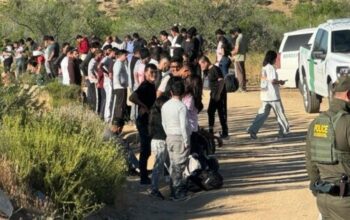The scam of the century is not Bernie Madoff. Nope, it is the $200 billion profit maker for unions, corporations and developers. The people lose. Money is made by the cabal for a train system that can not be built due to lack of money and ridership.
“A New York Times review of hundreds of pages of documents, engineering reports, meeting transcripts and interviews with dozens of key political leaders show that the detour through the Mojave Desert was part of a string of decisions that, in hindsight, have seriously impeded the state’s ability to deliver on its promise to create a new way of transporting people in an era of climate change.
Political compromises, the records show, produced difficult and costly routes through the state’s farm belt. They routed the train across a geologically complex mountain pass in the San Francisco Bay Area. And they dictated that construction would begin in the center of the state, in the agricultural heartland, not at either of the urban ends where tens of millions of potential riders live.”
You know it is bad when the NY Times outs the failure of the high speed rail. As we go into the recession maybe the legislature will stop the wild spending and payoffs.
How California’s Bullet Train Went Off the Rails

Ralph Vartabedian, NY Times, 10/10/22
LOS ANGELES — Building the nation’s first bullet train, which would connect Los Angeles and San Francisco, was always going to be a formidable technical challenge, pushing through the steep mountains and treacherous seismic faults of Southern California with a series of long tunnels and towering viaducts.
But the design for the nation’s most ambitious infrastructure project was never based on the easiest or most direct route. Instead, the train’s path out of Los Angeles was diverted across a second mountain range to the rapidly growing suburbs of the Mojave Desert — a route whose most salient advantage appeared to be that it ran through the district of a powerful Los Angeles county supervisor.
The dogleg through the desert was only one of several times over the years when the project fell victim to political forces that have added billions of dollars in costs and called into question whether the project can ever be finished.
Sign up for The Morning newsletter from the New York Times
Now, the tortured effort to build the country’s first high-speed rail system is a case study in how ambitious public works projects can become perilously encumbered by political compromise, unrealistic cost estimates, flawed engineering and a determination to persist on projects that have become too big to fail.
A New York Times review of hundreds of pages of documents, engineering reports, meeting transcripts and interviews with dozens of key political leaders show that the detour through the Mojave Desert was part of a string of decisions that, in hindsight, have seriously impeded the state’s ability to deliver on its promise to create a new way of transporting people in an era of climate change.
Political compromises, the records show, produced difficult and costly routes through the state’s farm belt. They routed the train across a geologically complex mountain pass in the San Francisco Bay Area. And they dictated that construction would begin in the center of the state, in the agricultural heartland, not at either of the urban ends where tens of millions of potential riders live.
The pros and cons of these routing choices have been debated for years. Only now, though, is it becoming apparent how costly the political choices have been. Collectively, they turned a project that might have been built more quickly and cheaply into a behemoth so expensive that, without a major new source of funding, there is little chance it can ever reach its original goal of connecting California’s two biggest metropolitan areas in 2 hours, 40 minutes.
When California voters first approved a bond issue for the project in 2008, the rail line was to be completed by 2020, and its cost seemed astronomical at the time — $33 billion — but it was still considered worthwhile as an alternative to the state’s endless web of freeways and the carbon emissions generated.
Fourteen years later, construction is underway on part of a 171-mile “starter” line connecting a few cities in the middle of California, which has been promised for 2030.
Meanwhile, costs have continued to escalate. When the California High-Speed Rail Authority issued its new 2022 draft business plan in February, it estimated an ultimate cost as high as $105 billion. Less than three months later, the “final plan” raised the estimate to $113 billion.
The rail authority said it has accelerated the pace of construction on the starter system, but at the current spending rate of $1.8 million a day, the train could not be completed in this century.
“We would make some different decisions today,” said Tom Richards, a developer from the Central Valley city of Fresno who now chairs the authority. He said project executives have managed to work through the challenges and have a plan that will, for the first time, connect 85% of California’s residents with a fast, efficient rail system. “I think it will be successful,” he said.
Unless rail authority managers can improve cost controls and find significant new sources of funding, they said, the project is likely to grind to a halt in future decades.
“I was totally naive when I took the job,” said Michael Tennenbaum, who was the first chair of the rail authority 20 years ago. “I spent my time and didn’t succeed. I realized the system didn’t work. I just wasn’t smart enough. I don’t know how they can build it now.”
The 2-Hour, 40-Minute Dream
The goal in California in 2008 was to carry passengers between Los Angeles and San Francisco in 2 hours, 40 minutes, putting it among the fastest trains in the world in average speed.
The most direct route would have taken the train straight north out of Los Angeles along the Interstate 5 corridor through the Tejon Pass, a route known as “the Grapevine.” Engineers had determined in a “final report” in 1999 that it was the preferred option for the corridor.
But political concerns were lurking in the background. Mike Antonovich, a powerful member of the Los Angeles County Board of Supervisors, was among those who argued that the train could get more riders if it diverted through the growing desert communities of Lancaster and Palmdale in his district, north of Los Angeles.
The extra 41 miles to go through Palmdale would increase costs by 16%, a difference in today’s costs of as much as $8 billion.
According to interviews with those working on the project at the time, the decision was a result of political horse-trading in which Antonovich delivered a multibillion-dollar plum to his constituents.
The horse-trading involved an influential land developer and major campaign contributor from Los Angeles, Jerry Epstein.
Epstein, who died in 2019, was a developer in the seaside community of Marina del Rey who was courting the Los Angeles County Board of Supervisors for a 40-year lease extension on a huge development.
Epstein, a member of the rail authority board, became a strong backer of Antonovich’s proposal for a Mojave Desert diversion on the bullet train.
“The Palmdale route was borne of a deal between Epstein and Antonovich, absolutely,” said Art Bauer, chief staff member on the State Senate Transportation Committee.
The dogleg from Burbank to Palmdale was never without advantages. For one thing, said Richards, the current rail authority chair, the direct route through the Grapevine would have had higher land acquisition costs and faced opposition by a major landowner. After the decision was made, Richards said, a follow-up study validated the choice.
But it has presented a complex engineering challenge, requiring 38 miles of tunnels and 16 miles of elevated structures.
And it introduced a fundamental conflict: If the train was to rush passengers between the state’s two urban hubs, how much speed should be sacrificed by turning it into a milk run across the huge state?
Then came the decision to start building a train between Los Angeles and San Francisco that reached neither city.
A Bullet Train for the Farm Belt
The idea of beginning construction not on either end, but in the middle — in the Central Valley, a place few in Los Angeles would want to go — was a political deal from the start.
Proponents of running the rail through the booming cities of Bakersfield, Fresno and Merced cited a lot of arguments: The Central Valley needed jobs. It would be an ideal location to test equipment. It would be the easiest place to build, because it was mostly open farmland.
But the entire concept depended on yet another costly diversion.
Instead of following Interstate 5 through the uninhabited west end of the valley, the train would travel through the cities on the east side — more passengers, but also more delays, more complications over acquiring land, more environmental problems.
Rail authority leaders said starting the bullet train in the center of the state reflected a decision to make sure it served 85% of the residents of California, not just people at the end points. Running it on the east end of the valley, they said, would ensure that it served existing cities; building on empty farmland would encourage new sprawl.
“The key to high-speed rail is to connect as many people as possible,” Richards said.
Rail authority spokesperson Annie Parker said studies in 2005 showed that building along the east side of the Central Valley provided better and faster service, although it was 6% more expensive. In any case, she said, the current route is what voters agreed to in 2008 in a $9 billion bond authorization.
State senators were under pressure to endorse the Central Valley plan, not only from Gov. Jerry Brown but also from President Barack Obama’s transportation secretary, Ray LaHood, who came to the state Capitol to lobby the vote.
Which Path Through the Mountains?
More political debate ensued over what route the train would take into the San Francisco Bay Area. The existing rail corridor through Altamont Pass, near Livermore, was a logical alternative. French engineering company Setec Ferroviaire reported that the Altamont route would generate more ridership and have fewer environmental impacts.
But as with so many decisions on the project, other considerations won the day. There was heavy lobbying by Silicon Valley business interests and the city of San Jose, which saw the line as an economic boon and a link to lower cost housing in the Central Valley for tech employees. They argued for routing the train over the much higher Pacheco Pass — which would require 15 miles of expensive tunnels.
In 2008, the rail authority issued its record of decision.
“It absolutely has to go through Pacheco and up through San Jose,” Richards said.



